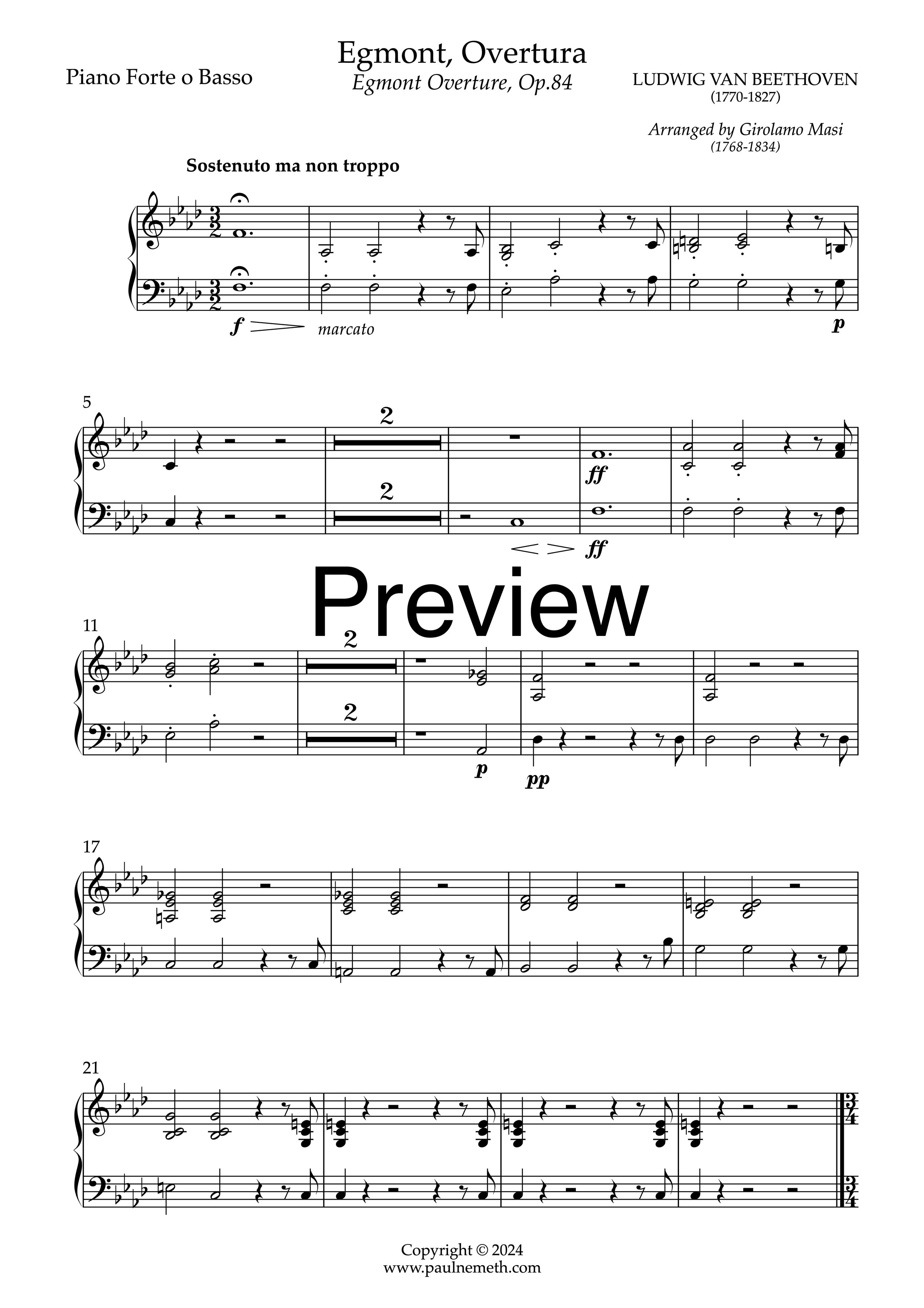Beethoven - Egmont Overture, Arranged for 6 Players by G. Masi (c.1815) - Score and Parts
Ludwig van Beethoven - Egmont Overture, Op.84, arranged for flute, 2 violins, viola, cello, and piano or double bass by Girolamo Masi (1768-1834), c.1815. Complete score (77 pages) and parts (41 pages), available as a PDF download.
Around 1815, three of Beethoven’s overtures appeared in print in London, published by Monzani & Hill in an arrangement made by Girolamo Masi (1768-1834). The three overtures, “Prometheus, Egmont, & Leonora” were arranged for the ensemble of flute, 2 violins, viola, cello, and either piano or bass. Masi had previously published the first three Beethoven symphonies in a similar arrangement for septet (2 violins, 2 violas, cello, and double bass, or 2 cellos) and these overture arrangements were most likely made around the same time. The inclusion of the flute as the only woodwind instrument is no accident, as the publishing firm of Monzani & Hill also made flutes.
Masi’s combination of only six instruments works surprisingly well, even with a double bass replacing the piano part. Masi meant for the bass part to be the same as the left hand of the piano part, so a separate double bass part has been prepared for the convenience of the player. This overture takes on a new life as a chamber work in this arrangement and is a fascinating new way to experience Beethoven’s work.
Ludwig van Beethoven - Egmont Overture, Op.84, arranged for flute, 2 violins, viola, cello, and piano or double bass by Girolamo Masi (1768-1834), c.1815. Complete score (77 pages) and parts (41 pages), available as a PDF download.
Around 1815, three of Beethoven’s overtures appeared in print in London, published by Monzani & Hill in an arrangement made by Girolamo Masi (1768-1834). The three overtures, “Prometheus, Egmont, & Leonora” were arranged for the ensemble of flute, 2 violins, viola, cello, and either piano or bass. Masi had previously published the first three Beethoven symphonies in a similar arrangement for septet (2 violins, 2 violas, cello, and double bass, or 2 cellos) and these overture arrangements were most likely made around the same time. The inclusion of the flute as the only woodwind instrument is no accident, as the publishing firm of Monzani & Hill also made flutes.
Masi’s combination of only six instruments works surprisingly well, even with a double bass replacing the piano part. Masi meant for the bass part to be the same as the left hand of the piano part, so a separate double bass part has been prepared for the convenience of the player. This overture takes on a new life as a chamber work in this arrangement and is a fascinating new way to experience Beethoven’s work.
Ludwig van Beethoven - Egmont Overture, Op.84, arranged for flute, 2 violins, viola, cello, and piano or double bass by Girolamo Masi (1768-1834), c.1815. Complete score (77 pages) and parts (41 pages), available as a PDF download.
Around 1815, three of Beethoven’s overtures appeared in print in London, published by Monzani & Hill in an arrangement made by Girolamo Masi (1768-1834). The three overtures, “Prometheus, Egmont, & Leonora” were arranged for the ensemble of flute, 2 violins, viola, cello, and either piano or bass. Masi had previously published the first three Beethoven symphonies in a similar arrangement for septet (2 violins, 2 violas, cello, and double bass, or 2 cellos) and these overture arrangements were most likely made around the same time. The inclusion of the flute as the only woodwind instrument is no accident, as the publishing firm of Monzani & Hill also made flutes.
Masi’s combination of only six instruments works surprisingly well, even with a double bass replacing the piano part. Masi meant for the bass part to be the same as the left hand of the piano part, so a separate double bass part has been prepared for the convenience of the player. This overture takes on a new life as a chamber work in this arrangement and is a fascinating new way to experience Beethoven’s work.

